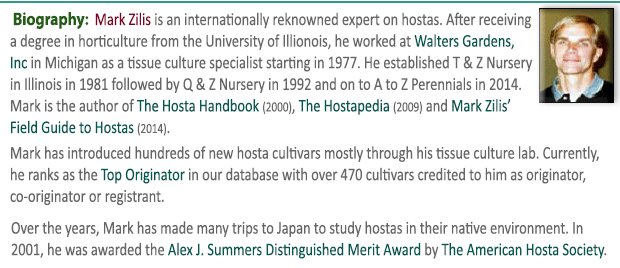|
  The Hostapedia by
Mark Zilis (2009) says that this native of
Korea forms a small size
(8˝ inches high by 22 inches wide) mound of
medium green foliage. The leaves are ovate-shaped and smooth
textured with the underside shiny and whitish. It has purple
flowers in early to mid-July followed by viable seeds. It has ridged flower scapes. The Hostapedia by
Mark Zilis (2009) says that this native of
Korea forms a small size
(8˝ inches high by 22 inches wide) mound of
medium green foliage. The leaves are ovate-shaped and smooth
textured with the underside shiny and whitish. It has purple
flowers in early to mid-July followed by viable seeds. It has ridged flower scapes.
Zilis states, "...true form is
hard to find in nurseries, though many mislabeled plants
(usually green-leaved Hosta sieboldii
seedlings) are sold...Plants listed as Hosta minor
"Korean" or H. minor "Gosan" usually represent the true
form of this plant. Its ridged scapes are the key diagnostic
trait."
The New Encyclopedia of Hostas by
Diana
Grenfell (2009) states: "Very variable in the wild and often wrongly named
in cultivation. Ideal for rock and sink gardens and other
containers but will also thrive at the front of the
border...Ridged, hollow scapes. Faint purple dotting at the
scape base. Reblooming flowers."
 W. George Schmid in his
Hosta Species Update on The Hosta
Library (2006) says, "This taxon is to some degree
variable in the wild and has white-flowered forms
appearing from time to time in wild populations. It is
characterized by lamellar ridges on the scape, a
definite identifier for section Lamellatae. H.
minor is one of the more stable Hosta species
populations in Korea.....Some plants purported to be the
species H. minor came to North America in the
1960s. For this reason it is somewhat “misunderstood” by
horticulturists and gardeners. The plants first
introduced were rather smaller than the average plant
size in natural population. Even good horticultural
practices did not result in producing an average leaf
size same as that observed in the wild. One reason is
that H. nakaiana
was sometimes sold as H. minor during the early
days. Even today (2010) it is still sometimes confused
with H. nakaiana
or H. capitata.
Both of these have a ball-shaped raceme when in bud,
with all flowers concentrated on top an abbreviated
raceme so can be differentiated by their flower
morphology." W. George Schmid in his
Hosta Species Update on The Hosta
Library (2006) says, "This taxon is to some degree
variable in the wild and has white-flowered forms
appearing from time to time in wild populations. It is
characterized by lamellar ridges on the scape, a
definite identifier for section Lamellatae. H.
minor is one of the more stable Hosta species
populations in Korea.....Some plants purported to be the
species H. minor came to North America in the
1960s. For this reason it is somewhat “misunderstood” by
horticulturists and gardeners. The plants first
introduced were rather smaller than the average plant
size in natural population. Even good horticultural
practices did not result in producing an average leaf
size same as that observed in the wild. One reason is
that H. nakaiana
was sometimes sold as H. minor during the early
days. Even today (2010) it is still sometimes confused
with H. nakaiana
or H. capitata.
Both of these have a ball-shaped raceme when in bud,
with all flowers concentrated on top an abbreviated
raceme so can be differentiated by their flower
morphology."


|



